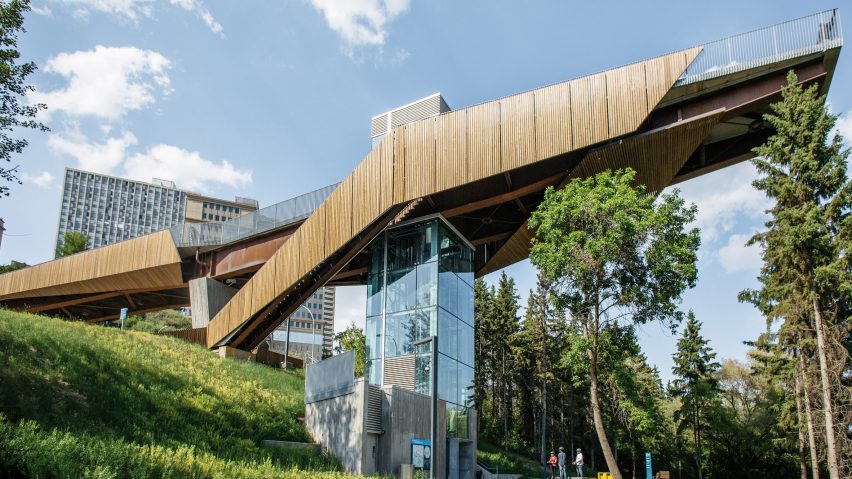Architecture firm Dialog has built a wooden pedestrian bridge, glass elevator and a tiny railway into a sloping terrain in Canada to lead from downtown Edmonton to the North Saskatchewan River Valley.
The Mechanized River Valley Access project by Dialog provides accessible entry to the network of trails and nature of the North Saskatchewan River Valley, the largest urban park in North America. Downtown Edmonton is cut off from the 18,000 acres of protected land because of an incline and busy highway.
"The large elevation difference and steep slopes of the river valley are part of its great beauty, but also makes access difficult for users with mobility challenges," Dialog said.
Thanks to the small railcar, known as a funicular, and a glass elevator any visitor, regardless of mobility, can enjoy the scenery. In just five minutes, on foot, or three minutes if using the mechanics, visitors can go "from the vibrant urban core to nature and the river valley".
To limit the ecological impact the Dialog closely monitored the environment during construction and used materials that matched the existing infrastructure of the river valley system.
This included rot-resistant Kebony wood, which will reduce the need for constant maintenance. Additionally the glass clad funicular cabins and elevator shaft are designed to minimise the structure's visual impact on the surrounding landscape.
A challenge of the project was finding an orientation that would engage with the surroundings, but not disrupt the existing topography.
"The final orientation takes pedestrians on a safe, immersive journey along the river bank with plenty of opportunities to take in the views and linger along the way," Dialog said.
Mechanized River Valley Access is divided into six sections, with the first a promontory that rests on top of the incline. The space is occupied by a large staircase, lined with galvanised steel railings, that takes visitors down into the river valley, a free funicular ride for less mobile guests and a large plaza that overlooks the terrain below.
Those in wheelchairs, cyclists, parents with strollers are all able to pass over the slope to the promenade below inside a glass cube attached to a track. The inclined elevator is powered by motor when travelling downhill and uses a winch connected to a cable to pull the cabins uphill.
Parallel to the funicular is a series of steps made with wood and stone. A broadwalk made from Kebony wood greets visitors when they disembark the funicular and staircase.
"The changes in grade do not allow the funicular to connect directly to the valley floor," the architects added. "The design solution combines the funicular on a 23.5 degree incline to the middle of the bank."
The next leg of the journey is a pedestrian bridge constructed using a pre-cast deck system that was installed onsite. It is raised above the highway which runs below and is lined with benches and rest areas.
At the river's edge a 19 metre (62.3 foot,) cantilever extends outward to form a lookout deck that grants "an immersive, panoramic vantage point in the river valley".
Visitors descend to the ground either by glass elevator or a staircase where they are met by another plaza with space for bike parking, several benches and more views of the landscape.
Dialog has offices in Vancouver, Edmonton, Toronto, Calgary and San Francisco. The studio's other projects include the New Central Library for Calgary completed with Snøhetta and office space for Telum, a collaboration with BIG.
Mechanized River Valley Access follows a series of public works projects in Edmonton, which is the capital city of Canada's Alberta province such as a naturally filtering swimming pool and drum-like pavilion that Canadian firm GH3 has built inside Borden Park.
Photography is by Dialog.

